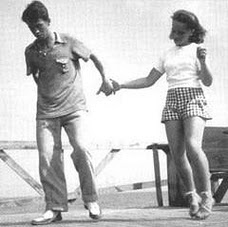
Do you want to learn to Shag? Come to the Myrtle Beach Area and they can show you how.
Top 5 of the 100 Greatest Beach Music Songs
• 1) Sixty Minute Man — Dominoes
• 2) Carolina Girls — General Johnson and the Chairman of the Board
• 3) I Love Beach Music — The Embers
• 4) Ms. Grace — The Tymes
• 5) Summertime's Calling Me — The Catalinas
The crowds backed off for the best “fast-dancers” at the beach, which included Billy Jeffers from Florence, S.C., who is seen here in 1939 shagging with Maggie Foss at Robert's Pavilion in Ocean Drive, S.C.
The term you hear '40s and '50s beachgoers use is “dance or fast-dancing” – not Shag or Jitterbug. Jitterbug, according to '40s dance stand-out Billy Jeffers from Florence, had the connotation of couples pumping arms and bouncing all over the floor. Mrs. Jeffers calls it “Yankee Jitterbug.” Holden Cauldfield, the fictional “Yankee” mentioned earlier, calls it “corny Jitterbug.”
The term Shag originally referred to a nationally popular dance of the 1930s. It's peculiar to this date as a description of the Jitterbug style of the Carolinians cropped up in the late '40s. According to Leon Williams of Columbia, black dancers in the Myrtle Beach area were doing a Jitterbug step that looked as if they were making love standing up. These dancers called their bumps and grinds – with a humorous reference to the older infinitely more sedate Shag of the '30s – the “Dirty Shag.” Williams, Big George Lineberry, Lacy Moore and other popular beach dancers say they toned down the Dirty Shag's undulations into a more subtle pelvic motion they called “Shagging.”
In the '40s and early '50s, dancers like Evans did steps that were personal and often unique. Those steps were their signatures, their own marks on the floor. “We never copied one another, not exactly,” said the late Carl “Tookie” Lee of Greensboro.
But as the '50s wore on, the Shag became more and more standardized. The crowds not only gawked, they observed every step, every convoluted turn, every gesture down to the tiniest detail. And they assimilated what they saw into their own repertoires, hoping to become just as popular, just as charismatic.
One of the most charismatic of these '50s dancers was Harry Driver from Dunn, N.C. Driver won just about every Jitterbug contest he entered. “He was the best dancer I ever saw, bar none,” said Lineberry. One night Driver was dancing past the Myrtle Beach Pavilion. He and his partner had taken the floor. As Driver danced, his pegged pants kept getting stuck in his loafers. Every so often he tugged at his knees to pry them loose. Next summer, as the story goes, all up and down the beach guys were tugging at their knees just so. It was the latest step.
In the late '50s the teenage-rebel look of the tailored pants, peroxided hair and short-shorts faded in favor of straight-legged khakis, crew cuts and Bermudas. And the Shag, for the first time in its history, became fashionable – the dance of debutante balls and college parties. As an elitist symbol for a few cocks-of-the-boardwalks and pavilion dance floors, the Shag was losing its mystique – but not completely. Not yet.
Start a new trend and get shagging.

